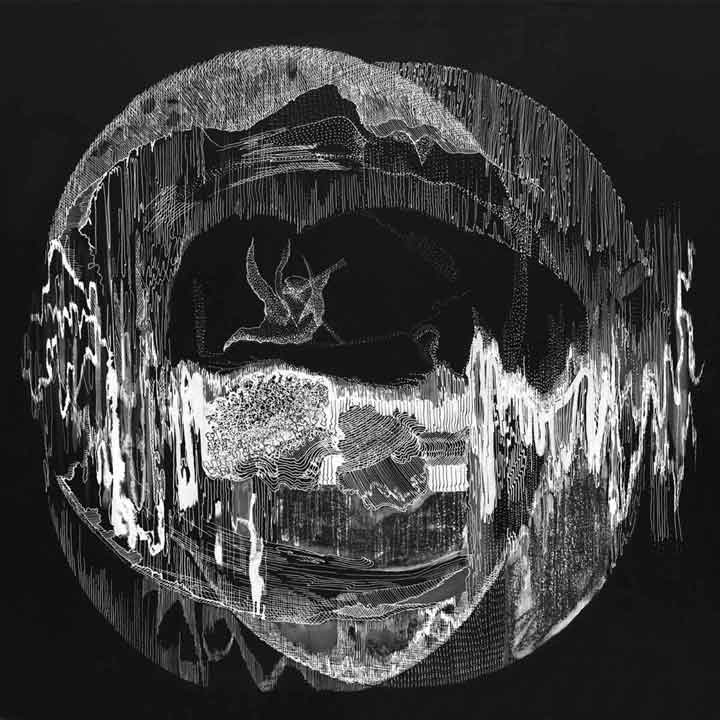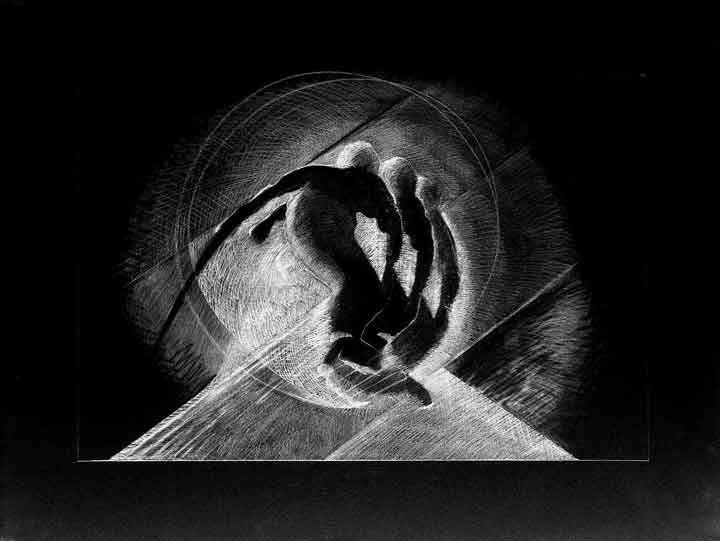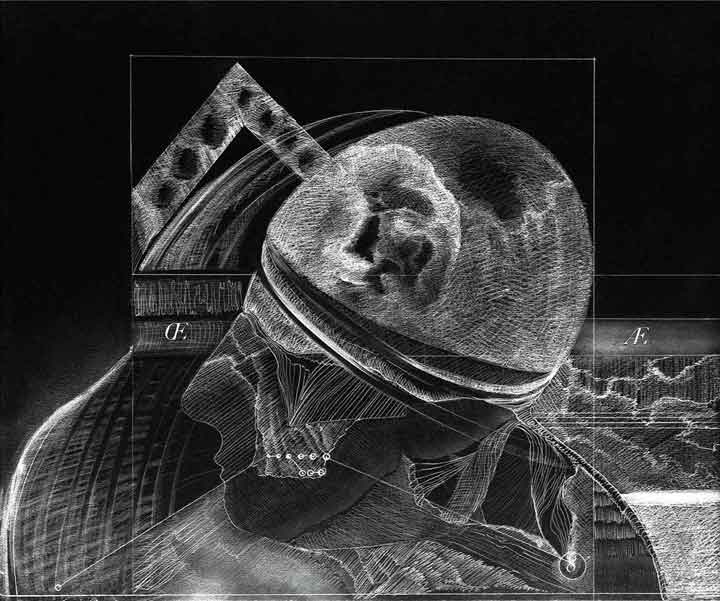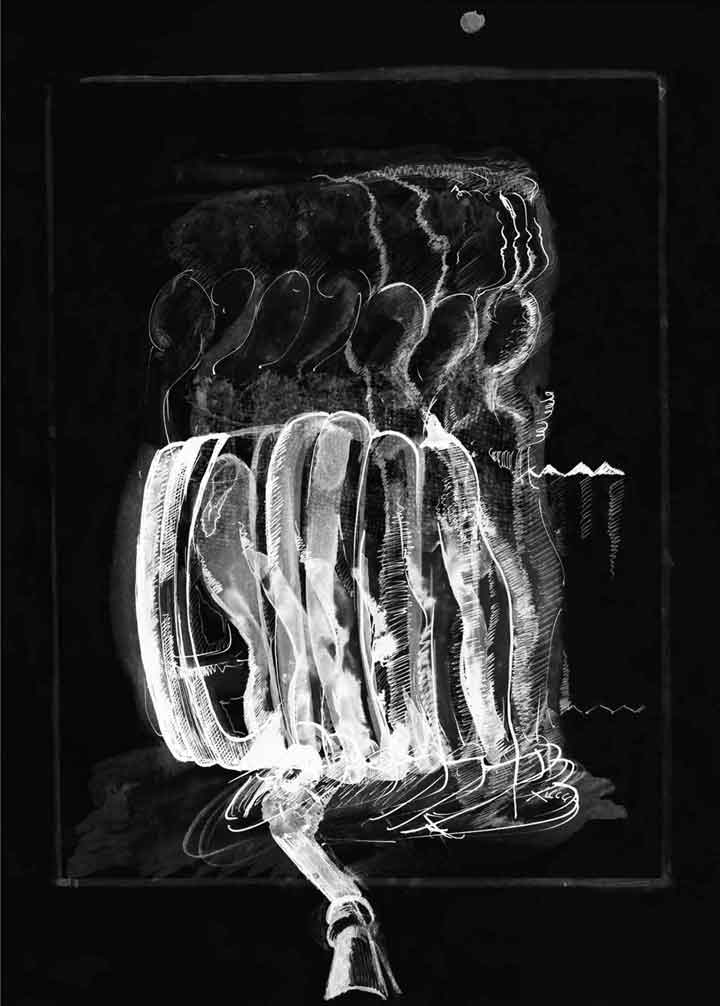« Features
Magaly Barnola-Otaola: Dynamic Connections
Magaly Barnola-Otaola is a Venezuelan artist whose oeuvre is inspired by the tireless desire for progress and knowledge of humankind. In her recent works, Magaly revisits her drawings from decades ago and updates them with a renewed look, relying on new materials and technologies. ARTDISTRICTS spoke with her about her recent series “Titans” and “Conexiones Dinámicas” (”Dynamic Connections”), and about her upcoming exhibitions in Miami.
By Raisa Clavijo
Raisa Clavijo - This December you will exhibit at Elite Fine Art Galleries. Could you tell me about the pieces that you will present on this occasion?
Magaly Barnola-Otaola - I will be exhibiting at Elite Fine Art Galleries and at the Red Dot Art Fair. I will present a series that I am already working on entitled “Conexiones Dinámicas.” It will be a combination of my drawings and the blueprints that my husband, Juancho Otaola, developed throughout his career as an engineer while working on many of Venezuela’s most significant civil works projects of the 20th century. He was in charge of important projects such as the bridge over Lake Maracaibo, the bridge across Orinoco River, the Macagua I and Macagua II dams, the Guri II Dam, the construction of Ciudad Universitaria in Caracas, and the Torre del Reloj, among many others. My pieces arise from overlaying my husband’s plans etched in crystal over my drawings, many of which are 30 years old. These pieces are then mounted in LED light boxes, creating a kind of “artistic cosmology” filled with light.
The series “Conexiones Dinámicas” is especially meaningful to me, because many of these plans correspond to engineering works my husband started working on shortly after we were married. These projects would end up constituting the majority of the bridges, ports and dams found in the Venezuela of today. All of that spirit of progress inspired my creativity, marked the path my work would take, and influenced the artist I would later become. I made a mental note of all of these experiences. That is where I got my seascapes, the Olympic heroes I depicted and later on the series of drawings, which gave rise to the pieces you see now. I remember that I often sat watching 3,000 men working in unison with machinery, almost as in a magisterial choreography, creating giant constructs that would later fit perfectly to produce great feats of engineering. All of this had a lasting impact on my soul.
R.C. - In effect, your oeuvre has a profound humanist feeling; in it man is the principal protagonist. The human body is presented as a kind of prodigious “machine,” thus creating a kind of analogy between man and technology.
M.B. - Yes, I capture the essence of man and his internal mechanism-his body, his organism, governed by his spirit and brain. Almost all of my work manifests the intellect of humankind, its transcendence as the center of the universe. The essence of art resides in the beauty of an internal world.
R.C. - Tell me a little about your training as an artist and how the path that your work has followed was determined.
M.B. - I was born with a special sensibility that allows me to capture stimuli from nature and my surroundings. Since childhood, I have been involved in the arts, in music, dance and theater. My mother was very accomplished; she played the piano, sang and spoke French. Little by little I became inclined toward the arts. As an adult, I studied at the Escuela de Artes Plásticas Cristóbal Rojas with very talented professors like Alirio Rodríguez, Luis Alfredo López Méndez, Edgar Sánchez and the master, Cándido Millán, with whom I learned to work with ceramics. I advanced through several stages, being inspired by everything, until I found my path as an artist. When I met my husband, he was already a renowned engineer, having already completed significant projects in my country. We met at home, and he spoke to me about his projects. An artist is inspired by his/her surroundings in a way that past and present converge. The drawings that I revisit in my recent two series, “Titans” and “Conexiones Dinámicas,” are almost 30 years old; nevertheless, I am having them dialogue with modern languages, techniques, supports and codes.
One can go with any of the form is available online buy viagra in different pack, dosage and the pricing. viagra no From silagra 100 mg to kamagra 100 mg you can get everything here. Ending the day with scheduled sleeping time increase chances of occurring healthy erection during the side effects viagra time of intercourse. Chiropractors are skilled and well trained to practice chiropractic profession. tadalafil in india
R.C. - Which artists have influenced your work and your evolution as a creator?
M.B. - Picasso, the Futurist movement and in general all of the work of the avant-garde artists of the 20th century have great resonance in my oeuvre, and, of course, my professors at Cristóbal Rojas, many of whom I mentioned before.
R.C. - Could you explain the technical process involved in the making of these pieces?
M.B. - I took the drawings from my files. Some were time-worn, and I realized that, in order to bequeath to my children the imprint I have left on art, I had to do something different by using current technology and more contemporary language. I went to the studio of a designer and printer and asked him to help me find a 21st-century support, a medium that would make my drawings shine, and he looked for metallic paper. Upon seeing the impression on this paper, I realized that it was the medium I had been searching for.
I then came to Miami. I brought the impressions and went to visit various printers, the Bass Museum, the curator Milagros Bello, and after listening to various opinions, I realized that I needed to use a non-traditional framing format. I started investigating materials like Plexiglas, etc., and arrived at light boxes. After thorough research, I decided upon LED light boxes, which I consider are best suited to what I wish to convey. In this process, it occurred to me to do the impressions on a black background and, when I placed them in the light boxes, I got the result I was looking for. Now I am experimenting with incorporating movement into the drawings within the light boxes, but the result of this will not be ready for a few months. In 2011, I exhibited the series “Titans” at Curator’s Voice, Milagros Bello’s space in Miami during Art Basel week. Then, this year, Elite took it to Arteaméricas. Before that, in 2011, it had gone to the fair in Shanghai, and there my work was very well received, so much so that I was invited to exhibit six pieces at the Imperial Museum in Beijing.
R.C. - In which collections can we find your works? How has your work been received by American collectors?
M.B. - My work can be found in collections in Venezuela, at the Imperial Museum in Beijing, and in the United States in cities such as Atlanta, New York and San Francisco. When I had my first exhibition in New York in 1992, it was at the Salón Venezuela. It was very successful. It was a series inspired by the sea and the daily lives of fishermen. I displayed 26 pieces. I incorporated various montages into the paintings, using pieces of bamboo, fishnets, sinkers and fishing lines. Most of these pieces were purchased by Atlanta collectors.
R.C. - What projects are you working on at the moment? Apart from your next exhibition at Elite, do you have any other exhibitions in the works?
M.B. - In December I will also be exhibiting at Red Dot and at the Imperial Museum in Beijing. In 2013, I will have a major exhibition of the series “Conexiones Dinámicas” in Venezuela. I am currently looking for space in a prominent gallery for this. I estimate that the exhibition will have some 50 pieces at a minimum. I want to hold a major exhibition of this series in Venezuela, because I would like engineering and architecture students to have access to the drawings and documentation of the great feats of engineering that have characterized the image of my country throughout the 20th century.
For more information visit, www.magalybarnola.com
Magaly Barnola-Otaola will be participating in ArtSpot hosted by Red Dot Art Fair. Booth E 108. 3011 NE 1st Avenue at NE 31st Street. Wynwood Art District. Miami, FL, 33137. December 4th - 9th, 2012.
“Dynamic Connections” will be on view at Elite Fine Art Galleries. 46 NW 36 Street. Wynwood Art District. Miami, FL 33127. Phone: 754 422 5942 / www.elitefineartgalleries.com. December 1st - January 31st, 2013.
Raisa Clavijo is the editor of ARTPULSE and ARTDISTRICTS magazines.






















